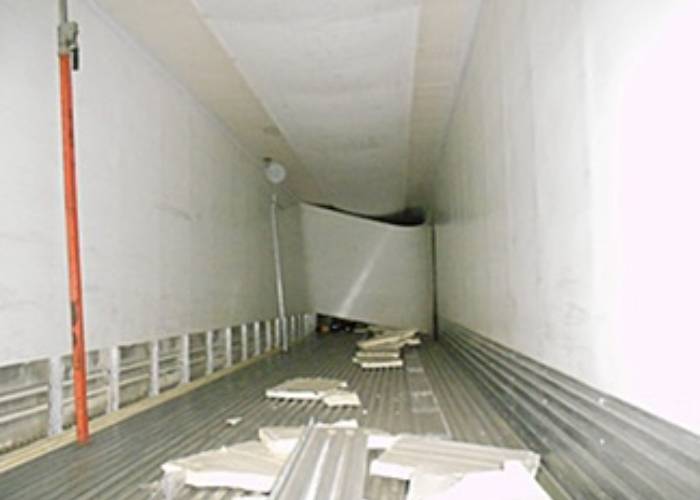TIPS ON EFFICIENCY
Tips on Dry Vans
Loading general freight on a dry van trailer;
Most common dry vans and refrigerated trailers are 102 inches in width and 53 ft in length. These trailers are mostly tandem trailers, not spread axles. These trailers must not exceed the 34,000 lbs max limit allowable on tandem axles.
Keep in mind that if your trailer is not loaded correctly, it can cause issues while in transit. The freight can shift and/or could possibly be overweight. To be sure this does not happen, you will want to make sure your trailer is loaded correctly and securely.
Here are some good tips;
Since 4x4 pallets side by side are only 96 inches in width, and the trailer is 102 inches in width, depending on how the pallets are stacked with merchandise, you will normally have leftover space in the width of your freight and the trailer sides.
One common loading practice to prevent your load from shifting is:
Chimney block:
Chimney block loading is where the loader will put one pallet up against the front wall. Turn the second pallet around and put it next to the other. This will lock both pallets in place. Turning every other pallet helps create durability and locks the load into its place. At least one single pallet will sit in a row by itself. The pallet is usually locked in place between the two pallets in the front and the two pallets in the rear. (Using a load locking device will help keep the pallet still). On some loads that are heavier, a second single pallet may be used. This helps balance out the load. Using two single pallets throughout your trailer, one is somewhere in the front and the second towards the back. This makes it a more efficient, smoother ride and helps distribute your weight equally.
TIPS ON REEFER TRAILERS
Things to check before loading a refrigerated trailer.
Make sure the unit is ¾ full of fuel. ( diesel, off-road diesel)
Make sure the chute is intact and no large holes.
Make sure the unit cools to a cooling temperature and maintains its temperature for at least 15 minutes.
Loading a refrigeration trailer can be a bit tricky and can't always be loaded the same as a dry van. Having the weight of the refrigeration unit on the front of the trailer, loading two full pallets in the front of the trailer with a truck full of fuel may cause you to be overweight on your steers.
Good loading practice:
When loading, 43,000 lbs or heavier. You may want to place one pallet by itself in the center of your trailer's front wall. To help secure the pallet in place and keep it from shifting during transit, you may want to consider using an extra wrap, straps, load bar, or some other type of barricade if available. This is a safe way to keep you under the 12,000 lbs weight limit on your steers. The remainder of the trailer would be loaded, boxing in the pallets to help secure the load using single pallets where needed, to equally distribute the weight throughout your trailer. Chimney block is also an option. Keep in mind pallet jacks may have difficulty maneuvering correctly if the trailer floor is to become damp or wet. This could lead to issues with loading and unloading.
TIPS ON AXLEING OUT:
Axleing out is when you have a loaded trailer within the 80,000 lb weight limit but possibly, overweight within either steer, drive axles, and/or tandem axles.
The best way to axle out is to find a certified scale. You can find them at most of the fuel stops along your route. A certified scale is calibrated and breaks down your total weight on each section/axle on your trailer.
After receiving the weight breakdown, and need to make adjustments to your weight. Find a safe place to park your rig. Set your trailer brakes and use wheel chocks for additional bracing.
All trailers have different releasing methods for releasing tandems. Check the manufacturing guide for your particular trailer on how to do this.
If you are overweight on your tandem axles, first unlock them. You are then going to want to slide your trailer "forward, "putting more weight on your drive axles. You will do the opposite if you are overweight on your drives. In this case, you would slide your trailer "back "on your tandem axles.
Note; Each pinhole = approximately 250 lbs
You can also adjust your weight distribution by sliding the fifth wheel.
To help with this process, put down the landing gear on your trailer to release pressure between the fifth wheel and the kingpin.
Each notch = approximately 125 lbs
After all the adjustments are completed, raise your landing gear and weigh your truck again to see if your weight is adjusted correctly.
Tips on Sealed trailers
Good practice;
When picking up a trailer that has been loaded and sealed, ask the shipper if the seal can be broken. Most shippers will not have a problem with you inspecting the load. They can put a new seal on when you are finished with your inspection. If the shipper refuses to allow you to inspect a sealed loaded trailer, get it documented on your (bol) bill of lading. Once you leave the premises with a signed bol, that is indicating that you are now 100% responsible for that shipment. Protect yourself and your company.
Things to look for:
Make sure that the freight matches the bill of lading.
Look to see that the pallets are uniform and tight.
Inspect the product for any damages.
Look for load barriers. If there aren't any, or if they are inadequate, it would be beneficial to add something to keep your load from shifting during your transit.
Taking these extra precautions will give you peace of mind while en route to your destination.












